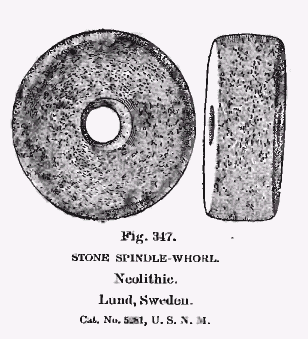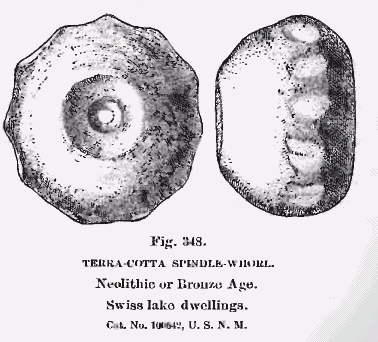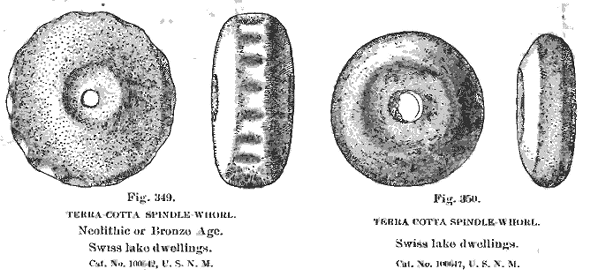

The Swastika
Spindle-Whorls.
Spindle-whorls are first to be considered. These are essentially prehistoric utensils, and are to be found in every part of the world where the inhabitants were sufficiently cultured to make twisted threads or cords, whether for hunting of

 The spindle-whorl was equally in use
in Europe and Asia during the Neolithic Age as in the Bronze Age. It continued
in use among the peasants in remote and outlying districts into modern
times. During the Neolithic Age its materials were stone and terra cotta;
during the Bronze Age they were almost exclusively terra cotta. They are
found of both materials. Recently a Gallo-Roman tomb was opened at Clermont-Ferrand
and found to contain the skeleton of a young woman, and with it her spindles
and whorls. (1)
The spindle-whorl was equally in use
in Europe and Asia during the Neolithic Age as in the Bronze Age. It continued
in use among the peasants in remote and outlying districts into modern
times. During the Neolithic Age its materials were stone and terra cotta;
during the Bronze Age they were almost exclusively terra cotta. They are
found of both materials. Recently a Gallo-Roman tomb was opened at Clermont-Ferrand
and found to contain the skeleton of a young woman, and with it her spindles
and whorls. (1)The existence of spindle-whorls in distant and widely separated countries affords a certain amount of presumptive evidence of migrations of peoples from one country to another, or of contact or communication between them. If the people did not themselves migrate and settle the new country, taking the spindle-whorls and other objects with them, then the spindle-whorl itself, or the knowledge of how to make and use it, must in some other way have gotten over to the new country.
This argument of migration, contact, or communication does not rest solely on the similarity of the whorls in the distant countries, but equally on the fact of spinning thread from the fiber; and this argument is reinforced by the similarity of the operation and of the tool or machine with which it was
 done.
It has been said elsewhere that the probability of communication between
widely separated peoples by migration or contact depended for its value
as evidence, in some degree, upon the correspondence or similarity of
the object considered, and that this value increased with the number of
items of correspondence, the closeness of similarity, the extent of the
occurrence, and the difficulty of its performance. So we pass to the similarity
in size, appearance, mode of manufacture, and, finally, the use of the
whorls of the two continents.
done.
It has been said elsewhere that the probability of communication between
widely separated peoples by migration or contact depended for its value
as evidence, in some degree, upon the correspondence or similarity of
the object considered, and that this value increased with the number of
items of correspondence, the closeness of similarity, the extent of the
occurrence, and the difficulty of its performance. So we pass to the similarity
in size, appearance, mode of manufacture, and, finally, the use of the
whorls of the two continents.Switzerland --- Lake dwellings. --- Figs. 345 and 346 show stone spindle-whorls form prehistoric Swiss lake dwellings. These are in the U. S. National Museum, and with them are dozens of others of the same kind and style from all other parts of Europe. Fig. 347 shows a stone spindle-whorl form Lund, Sweden. It is the U. S. National Museum and was contributed by Professor Jillson. Figs. 348, 349, and 350 represent terra-cotta spindle-whorls from the Swiss lakes, These specimens were selected to show the different patterns, to illustrate their unlikeness instead of their likeness, to give an understanding of the various kinds of whorls rather than that they were all one kind, a fad which should be kept in mind during this argument.

ENDNOTES:
1. Bull. Soc. d'Anthrop., Paris, October, 1893, p. 600. [Back]
<< Previous Page Next Page >>
© 2004-2007 Northvegr.
Most of the material on this site is in the public domain. However, many people have worked very hard to bring these texts to you so if you do use the work, we would appreciate it if you could give credit to both the Northvegr site and to the individuals who worked to bring you these texts. A small number of texts are copyrighted and cannot be used without the author's permission. Any text that is copyrighted will have a clear notation of such on the main index page for that text. Inquiries can be sent to info@northvegr.org. Northvegr™ and the Northvegr symbol are trademarks and service marks of the Northvegr Foundation.

|